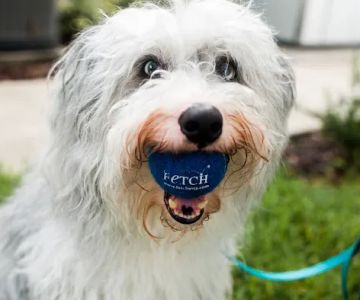- How to Train a Dog to Fetch a Ball
- Why Fetch is Important for Dogs
- Step-by-Step Guide to Training Your Dog to Fetch
- Troubleshooting Common Fetch Training Issues
- Why Choose Hidden Brook Veterinary for Your Dog's Needs
How to Train a Dog to Fetch a Ball
Training your dog to fetch a ball can be one of the most fun and rewarding activities you both can share. Not only does it give your dog great exercise, but it also strengthens the bond between you and your pet. Whether you’re training a puppy or an older dog, the steps to teach them to fetch a ball are straightforward. With patience, consistency, and the right approach, your dog will be fetching like a pro in no time.
Why Fetch is Important for Dogs
Fetching is more than just a game; it’s an excellent way to keep your dog physically and mentally stimulated. Regular playtime helps your dog burn off excess energy, which can prevent behavioral problems. Additionally, playing fetch strengthens your dog’s muscles, improves coordination, and encourages healthy joint movement. It’s also a great way to reinforce good behaviors through positive reinforcement. Not to mention, it's a fun way for you to interact with your dog and keep them engaged.
Step-by-Step Guide to Training Your Dog to Fetch
Follow these simple steps to teach your dog how to fetch a ball. It’s a great bonding experience that’s also beneficial for their physical fitness!
1. Introduce the Ball
Start by showing your dog the ball and letting them sniff it. Allow them to get comfortable with it before attempting to throw it. If your dog is hesitant, try rolling the ball gently on the floor to spark their interest. The goal is to make the ball an object of curiosity and excitement.
2. Encourage Your Dog to Chase the Ball
Once your dog is interested in the ball, toss it a short distance away. Use a cheerful tone and say a command like "fetch!" When your dog runs after the ball, praise them enthusiastically. At first, your dog may not understand what to do once they’ve got the ball, but they’ll eventually associate chasing the ball with praise and excitement.
3. Reward and Reinforce
When your dog picks up the ball, call them back to you with a command like "bring it here." If your dog brings the ball back to you, reward them with a treat and lots of praise. If they don’t bring it back right away, encourage them to do so by using a friendly and enthusiastic voice. Repetition is key here, as your dog will need to learn that fetching and returning the ball is a rewarding activity.
4. Keep Training Sessions Short and Fun
Training should always be fun and engaging. Keep each training session short—about 10 to 15 minutes—and make sure to end on a positive note. This prevents your dog from becoming bored or frustrated. You can gradually increase the distance you throw the ball as your dog becomes more confident in fetching and returning it.
Troubleshooting Common Fetch Training Issues
Not every dog will immediately pick up on the game of fetch, and that’s okay. Here are some common issues you may encounter and how to address them:
1. Dog Won't Bring the Ball Back
If your dog runs after the ball but refuses to bring it back, try using a high-value treat to lure them back to you. It might take a little time, but with consistent training and positive reinforcement, your dog will learn to associate returning the ball with receiving praise and rewards.
2. Dog Gets Distracted by the Ball
Some dogs get so excited by the ball that they forget about the fetch command and start playing with the ball on their own. Try using a leash to gently guide your dog back towards you, and offer lots of praise when they bring the ball to you. You can also try a different ball or toy that might be more engaging for your dog.
3. Dog Is Too Old or Not Interested in Fetch
If you’re trying to train an older dog or a dog that’s not interested in fetch, don’t worry. Some dogs are naturally more energetic and playful, while others may not be as motivated to fetch. For these dogs, it’s important to find other forms of enrichment that suit their personality. You might want to try training with a different toy, or you could focus on short training sessions that involve gentle play and bonding time.
Why Choose Hidden Brook Veterinary for Your Dog’s Needs
If you’re looking for expert advice or need support in training your dog, Hidden Brook Veterinary is here to help. Our team offers resources and guidance to ensure your dog remains healthy, happy, and well-trained. Whether you’re seeking health advice, training tips, or the best products for your dog, Hidden Brook Veterinary is your trusted partner in pet care.
Visit us today to discover a wide range of services and products that will help you train your dog and maintain their overall health!











